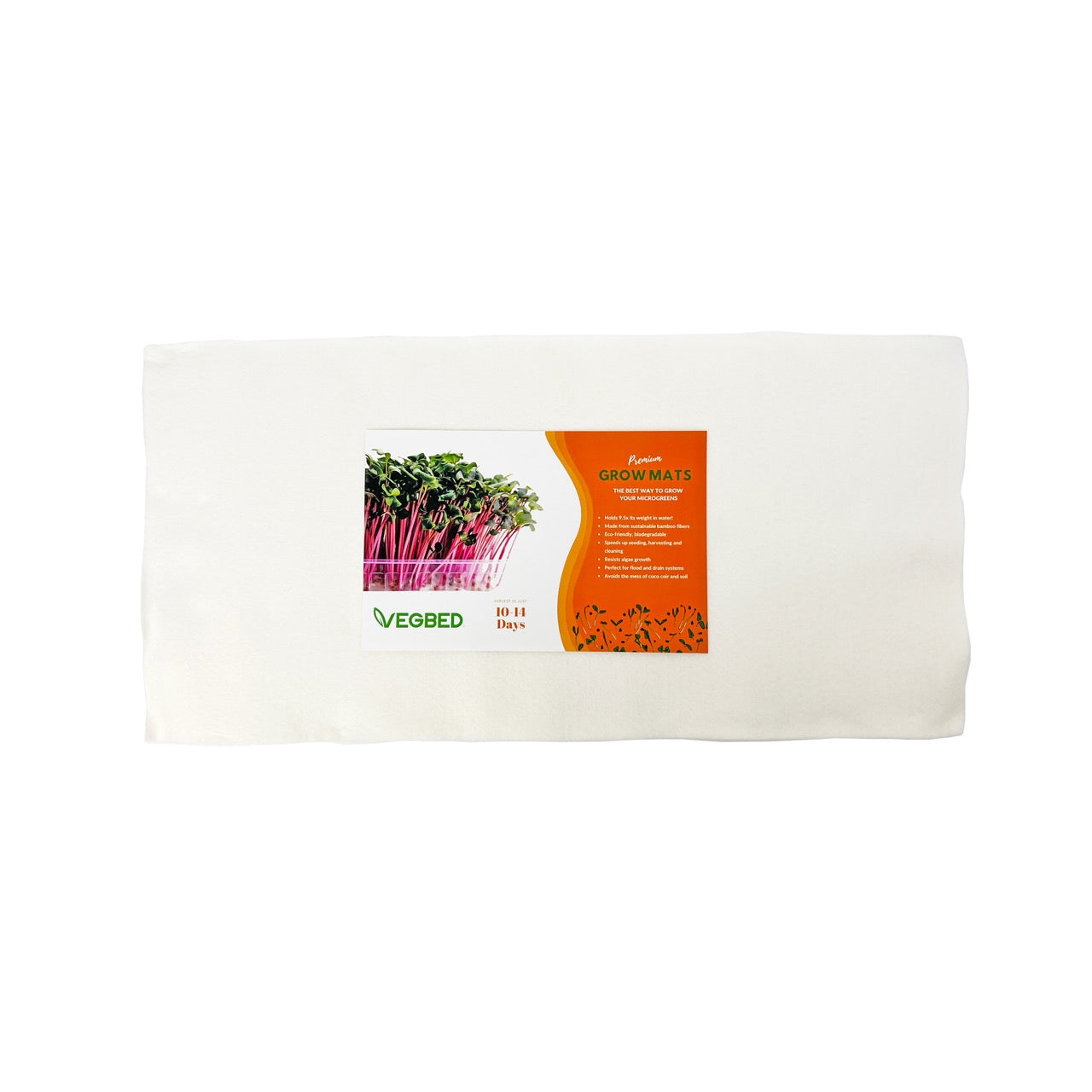Microgreens are celebrated for their vibrant flavors, dense nutrients, and quick growth cycles. As a microgreen grower, you may have wondered: “Do microgreens need nutrient solutions to thrive?” The answer isn’t a straightforward yes or no—it depends on your growing setup, goals, and the resources you use.
In this blog, we’ll break down when nutrient solutions are necessary, how they work, and the role sustainable growing mediums like Vegbed bamboo mats play in achieving lush, healthy microgreens.
Understanding Microgreen Growth: The Basics
Microgreens are young plants, harvested just after they sprout their first true leaves. Their growth is driven primarily by:
-
Seeds: Packed with energy and nutrients to fuel the plant’s early development.
-
Water: Essential for hydration and nutrient absorption.
-
Light: Provides energy for photosynthesis, ensuring robust growth.
At this stage, many growers wonder: Do I need to add nutrients to the mix? Let’s dive into the factors that determine the need for nutrient solutions.
When Nutrient Solutions Are NOT Required
-
Growing in Soil
-
Why: Quality soil often contains the essential nutrients microgreens need. As the seeds germinate, they tap into both the nutrients stored in the seed and the soil.
-
Ideal for: Growers seeking simplicity and a natural approach.
-
Short Growth Cycles
-
Why: Microgreens are typically harvested within 7–14 days, meaning they don’t require extensive external nutrition compared to mature plants.
-
Nutrient-Rich Growing Mediums
-
Why: Some growing mediums, like certain types of compost or enriched coco coir, contain enough nutrients to support microgreen growth without additional inputs.
At Vegbed, we emphasize simplicity and sustainability. Our bamboo grow mats are designed for seamless growing, with optimal water retention and minimal mold risk—perfect for those who prefer a no-fuss growing process.
When Nutrient Solutions ARE Required
-
Hydroponic Systems
-
Why: Hydroponics involves growing plants in water rather than soil, meaning nutrients must be dissolved in the water to provide the plants with essential minerals.
-
High-Yield Goals
-
Why: If you’re growing microgreens commercially, you may want to boost yields or extend the harvest window. Nutrient solutions can support more vigorous and uniform growth.
-
Specific Crops
-
Why: Some microgreens, like sunflowers and peas, are more nutrient-hungry than others. Adding nutrients ensures they develop strong stems and vibrant leaves.
-
Reusing Growing Mediums
-
Why: If you’re using a medium like coco coir multiple times, nutrients from the first crop may be depleted, necessitating supplementation.
How to Choose the Right Nutrient Solution
If you’ve determined that your setup requires nutrients, it’s important to select the right type. Here’s what to consider:
1. Essential Nutrients
-
Macronutrients: Nitrogen (N), Phosphorus (P), and Potassium (K) are the primary building blocks for plant growth.
-
Micronutrients: Elements like magnesium, calcium, and zinc play a crucial role in enzyme activation and overall plant health.
2. Organic vs. Synthetic Nutrients
-
Organic: Derived from natural sources like fish emulsion or seaweed, organic nutrients are great for eco-conscious growers.
-
Synthetic: These are lab-formulated and can provide precise nutrient ratios, making them ideal for hydroponic setups.
3. Ease of Use
-
Opt for pre-mixed liquid solutions if you’re new to nutrient management. Experienced growers might prefer powdered formulas for custom blending.
4. Compatibility with Your Growing Medium
-
Ensure the nutrient solution you choose works well with your medium. Vegbed bamboo mats, for example, support nutrient absorption in hydroponic and soil-based setups alike.
Avoiding Common Mistakes with Nutrients
Adding nutrients to your microgreens can be incredibly rewarding, but it’s important to avoid these pitfalls:
-
Overfeeding
-
Excess nutrients can lead to “nutrient burn,” stunting growth or causing discoloration. Start with lower concentrations and adjust as needed.
-
Improper pH Levels
-
Nutrient uptake is pH-dependent. Keep your water’s pH between 5.5 and 6.5 for optimal results.
-
Ignoring Quality
-
Cheap or unbalanced nutrient mixes can harm your plants. Invest in high-quality solutions for better yields.
Vegbed Bamboo Mats: The Perfect Partner for Nutrient Solutions
At Vegbed, we believe in simplifying the microgreen-growing process while maintaining sustainability. Our bamboo grow mats are:
-
100% Biodegradable: An eco-friendly choice for reducing waste.
-
Soil-free: Promotes healthier microgreens with fewer issues.
-
Water-Retentive: Ideal for nutrient absorption in hydroponic setups.
Whether you’re using nutrient solutions or growing in soil, our mats provide a versatile, mess-free foundation for your crops.
Do You Need Nutrients? It Depends on Your Goals
In the end, whether you need nutrient solutions for your microgreens depends on your growing method, goals, and resources. For beginners or casual growers, the simplicity of soil or a high-quality grow mat like Vegbed’s is often enough. However, for advanced growers seeking higher yields or experimenting with hydroponics, nutrient solutions can be a game-changer.
Whatever your approach, remember that growing microgreens should be fun, rewarding, and aligned with your values. At Vegbed, we’re here to support you every step of the way.
Final Thoughts
Microgreens are a versatile, nutrient-packed addition to any diet. By understanding the role of nutrients and how to manage them, you can ensure your plants thrive, whether you’re growing for fun, health, or profit.
Happy growing! 🌱



